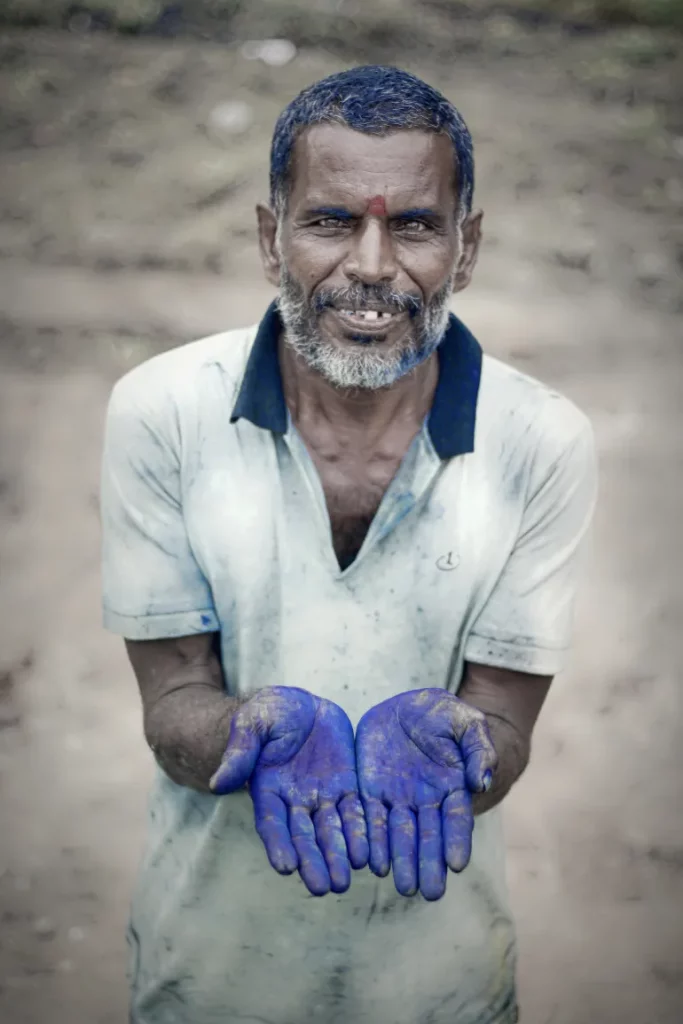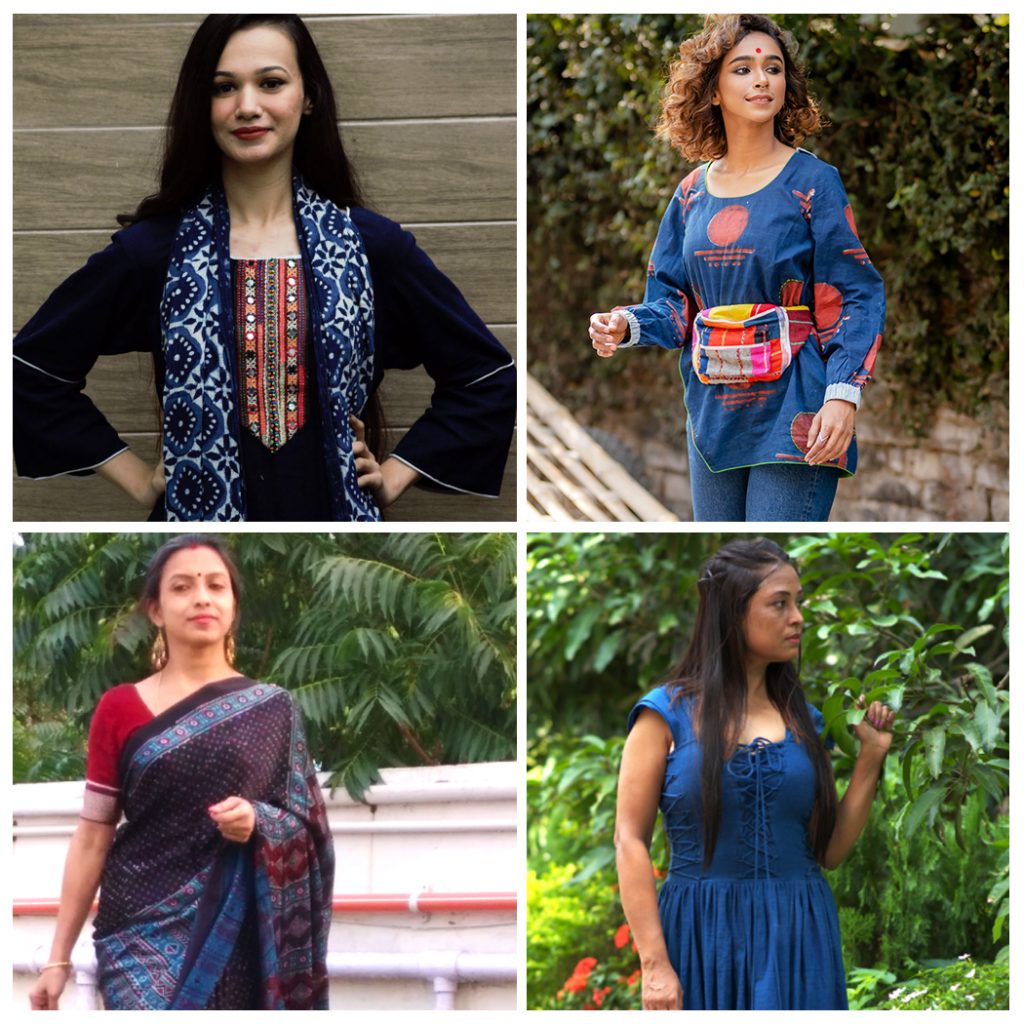Indigo – which is a historic colour, holds a significant place in Indian history and tradition. As Georg Stark, a contemporary textile artist, aptly stated, “The origin of taste, of fabric printing is India.”
The name “Indigo” itself, which means ‘the Indian’ or ‘from India,’ – highlights its deep-rooted association with our country. India was the first nation to establish Indigo production for international trade, creating some of the finest and most luxurious Indigo dyes and fabrics since ancient times. The demand for Indian Indigo products soared, making them highly sought after in early civilizations worldwide, often leading to intense conflicts. Consequently, the colour Indigo became a symbol of prestige, adorning fabrics exclusively reserved for royalty or wealthy members of society.
While Indigo’s first-known use as a fabric dye can be traced back 60,000 years to Huaca Prieta in Peru, ancient civilizations in the Middle East, Egypt, Britain, South America, and West Africa were also well acquainted with this colour. In India, the production of Indigo can be traced as far back as the 4th century BC. The Indigofera tinctoria plant, abundant in India, was harvested and underwent a complex and time-consuming process of soaking, fermenting, and drying of its leaves – from which the Indigo-coloured dye was extracted and which evolved into a fine art over the centuries. As the demand for Indian Indigo grew, the mastery of creating luxurious and vibrant shades of blue became a closely guarded secret, passed down through generations within families.

The Significance of the Colour Indigo
Indian Indigo, known as “Neel,” was always a highly sought-after commodity in the international market since ancient times, traded extensively with civilizations like Mesopotamia, Egypt, and Greece. Indigo dye holds immense cultural and historical significance in India, with its deep blue colour symbolising spirituality, wealth, and prosperity. It was also believed to possess therapeutic properties and used in Ayurvedic medicine. Indigo is also revered as a Blue Goddess, with Hindu deities like Devi Kali and Bhagwan Shri Krishna often depicted in the colour blue, representing the cosmos.
A Brief History of Indigo
India was the hub of Indigo production, supplying this vibrant dye to the Greeks and Romans who used it to dye fine textiles. Clothes made from fine textiles dyed with Indigo were worn by royalty or the truly wealthy. During the Edo period in Japan, when common people were banned from wearing silk and cotton became popular, Indigo gained even greater importance – because it was one of the few substances that could dye cotton fabric.
Throughout the Middle Ages, Indigo remained a scarce commodity in Europe. However – with the establishment of the Silk Road, the demand for Indigo surged significantly. European powers then subsequently established plantations in colonies situated in Central and South America, Haiti, Jamaica, and the Virgin Islands. In North America, Indigo was introduced to South Carolina, where it swiftly became the colony’s crucial crop and it would later lead to the creation of Indigo dyed denim fabric and even later on – the blue jeans that we wear and love even today. Owing to its immense trading value, Indigo was often referred to as “blue gold”.
The Tragic Story of Indigo in India
Even up to the 19th century, when synthetic Indigo was discovered, the Indigofera plant was the only natural source of the long-lasting Indigo blue. Even though several countries produced Indigo, India remained the major producer of Indigo dye for the world. In the late 1500s, French and Norwegian officials banned Indian Indigo, calling it the “devil’s dye”, to protect the production of their own version of Indigo which was a woad-based blue dye. For the East India Company and later the British rulers, Indigo turned out to be one of their most profitable commodities.
Many Indian farmers were forced by the British into growing Indigo crops instead of food crops, and the dye was then bought by them from the farmers at unfairly low prices – while the Indian farmers starved due to lack of earnings and the ability to grow their own food. This was because Indigo was a very precious source of dye for the textile mills in England. Since it grew well in Bengal and Bihar – the British utilised the zamindar (or landowner and landlord) system to force the cultivation of Indigo.
In mid-19th century Bengal, farmers were provided loans to grow Indigo crops – with such high interest rates that it would pass on to the next generations, forcing generations of our farmers to become bonded Indigo labourers. The price at which the Indigo dye was purchased from the farmers was abysmally low – only 2.5 % of what the Indigo could actually fetch in the global marketplace.
In 1859 – the exploited Bengal farmers led a revolt that brought Indigo production to its knees. An official commission was set up to study the status of Indigo farmers. The Indigo Commission report observed, “not a chest of Indigo reached England without being stained with human blood.”

With the discovery of chemical dye by Germany (in 1878), the global market for Indigo collapsed and the farmers’ situation became even more tragic. Later on – the first commercially viable method of creating Indigo dye was developed in 1901. Different versions of this method are in use even today – and a lot of the Indigo dye produced globally is created using this synthetic process.
The Process of Creating Indigo Dyed Fabric
The creation of Indigo dye from the Indigofera plant involves several stages. First, the leaves are harvested and immersed in a large tank filled with water, where they undergo fermentation. After the fermentation process, the leaves are removed, and the water is transferred to another tank, where the solution oxidizes, and sediment settles at the bottom. Finally, the sediment is dried and packed into cakes, forming the Indigo powder which is used to dye fabric in the colour we know and love.

Indigo Art & Craft Forms
Let’s delve into the various expressions of Indigo textiles that exist today.
Traditional Indigo Textiles: Indigo-dyed textiles have long been synonymous with Indian craftsmanship. Rajasthan and Gujarat are known for their intricate “Bandhani” tie-dye technique, while Kutch is renowned for its famous “Ajrakh” prints. These traditional Indian textiles combine Indigo with other natural dyes, resulting in mesmerizing patterns on fabrics like cotton, silk, and wool. Artisans skilfully create sarees, stoles, dupattas, and home furnishings, showcasing the rich artistry of Indian craftsmanship.
Indigo Block Printing: The tradition of Indigo block printing is deeply ingrained in Indian culture. Artisans intricately carve designs onto wooden blocks, which are then used to print patterns onto fabric using Indigo dye. This age-old technique has given rise to iconic styles like “Bagru,” “Dabu,” and “Sanganer” prints, each featuring unique motifs and patterns. Indigo block-printed textiles continue to be highly valued and sought after, exuding timeless appeal.
The Shibori Twist: Originating in Japan, the Shibori tie-dyeing technique has found a home in India, seamlessly merging with the country’s Indigo traditions. Indian artisans have embraced Shibori, infusing it with their own aesthetics. The result is a mesmerizing fusion of traditional Indian tie-dye techniques and contemporary designs. Shibori Indigo textiles exhibit intricate patterns created through various folding, twisting, and binding techniques, captivating fashion connoisseurs both in India and abroad.
Trends in Indigo Art & Craft
The allure of Indigo-themed art and craft remains strong, and has experienced a resurgence in recent years, both within India and on the global stage. Artisans, designers, and craft communities are preserving traditional Indigo dyeing techniques while incorporating innovative approaches to cater to modern sensibilities.
The Indian marketplace now offers a wide range of Indigo-themed creations to cater to diverse tastes and preferences. Traditional Indigo textiles continue to be in high demand, with artisans producing exquisite fabrics, sarees, scarves, ready-to-wear garments, and home decor products. These creations not only celebrate India’s cultural heritage but also provide sustainable livelihoods for numerous artisans across the country. Indigo-dyed fabrics, with their timeless appeal and eco-friendly nature, have garnered attention from conscious consumers appreciating the beauty of handmade and sustainable products.

Indigo-themed art and craft have also made their mark in contemporary art. Artists are experimenting with Indigo as a medium, creating stunning paintings, installations, mixed media artworks, and studio pottery. The versatility of Indigo allows artists to explore various techniques and textures, resulting in captivating pieces that blend tradition with innovation.

In recent years, several initiatives and organisations have emerged to support and promote Indigo art and craft in India. Craft clusters and cooperatives provide artisans with training, resources, and marketing opportunities. These initiatives preserve traditional knowledge and techniques while ensuring fair wages for artisans.
Furthermore, social enterprises and online platforms play a crucial role in connecting artisans with a wider audience. They provide a platform for artisans to showcase their Indigo creations and directly engage with customers who appreciate the value of handcrafted products. This direct interaction helps preserve traditional techniques and ensure a sustainable livelihood for artisans.
How we Celebrate Indigo
The Indigo art and craft market in India is experiencing a vibrant resurgence, driven not only by its historical significance but also by its ability to adapt to modern sensibilities. As consumers become increasingly conscious of sustainability and seek unique, handmade products, Indigo-themed creations offer a perfect blend of heritage, craftsmanship, and eco-friendliness. The versatility of Indigo allows it to seamlessly blend with a variety of design styles, from bohemian and rustic to contemporary and minimalist.
In conclusion, Indigo art and craft hold a treasured place in India’s cultural heritage. From traditional textiles to contemporary art forms, Indigo continues to captivate and inspire with its deep blue allure. The timeless beauty and eco-friendly nature of Indigo creations make them cherished possessions for those who appreciate the richness of handmade, sustainable, and culturally significant products. As we celebrate Indigo, we not only honour the traditions of the past but also empower artisans and ensure the longevity of this remarkable art form for generations to come.
Image Credits
https://www.aljazeera.com/features/2020/12/13/indigo-and-the-story-of-indias-blue-gold
unsplash.com, https://blog.fabrics-store.com/2020/09/29/indigo-in-india-the-colour-of-desire/
